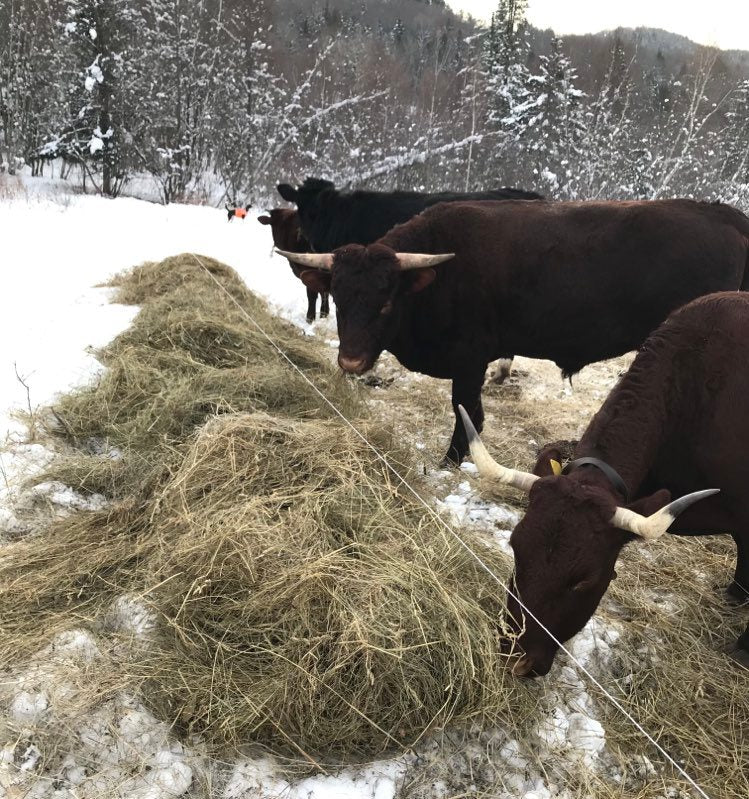
Winter Grazing in Vermont
Share
The downside of farming in Vermont, especially farming that is focused on rotational grazing, is that 4-6 months of the year we have snow on the ground! Since I installed permanent fencing several years ago, I've been enjoying the ability to "graze" the cows on hay for a good part of the winter season.
Here's how my system works. After grazing wraps up sometime in October, the cows head back to cow shed area to eat hay bales in the "sacrifice pasture". That means that this small area will get churned up, over grazed and muddy but all the other pastures get a break from hoof traffic while the grass is not growing and the soil is wet. The cows stay there until the ground freezes up and it's safe for them to head back out without damaging the dormant grasses.
Once back out on pasture, I feed hay out to cows twice a day under a single hot wire of electric fence.

Why feed the hay under an electric fence? Well, cows have a lot of trouble making plans for the future. When given hay, they first eat until their stomach is full and then start looking for a nice place to lay down and chew their cud. If they have access to it, a pile of hay makes a marvelous bed. So they lay down on the hay to chew their cud for a bit and then they eventually stand back up and poop and pee on the hay they just slept on. Now they're hungry again but they don't want to eat that gross hay that somebody pooped on!
The electric fence wire keeps the hay from immediately becoming a cow bed and thus reduces hay waste. It is also very easy to move around the pasture, so when the poop builds up in certain area, I just move the hot wire to a cleaner section. This is great for the grass since it is getting a nice coating of organic matter and nutrients in the form of hay and cow waste. In the spring, the pasture the cows wintered on will be a little slower to green up since the grass has to work its way through a layer of hay but as it works into the soil over the growing season, the pasture gets a long lasting boost of nutrients and organic matter. To spread this effect, I change which pasture is used for wintering cows each year.

Since we are in Vermont, the snow usually gets deep enough at some point in February or March that the cows might be able to just...walk out of the pasture. At that point they return to the cow shed area with its taller more secure fencing. But if it's a "low snow" year, they can stay out until the ground starts to thaw again.
How do the cows handle harsh winter weather? The most important thing is to have a breed of cow that is adapted to winter weather. I raise American Milking Devons which have been bred and raised in Vermont for several hundred years now (the first Devons arrived in New England along with some of the first Europeans). They grow a dense winter coat and are generally a compact, healthy breed. To help them deal with wind and storms, the cows always have access to a fairly dense wooded area in their winter pasture, trees, especially conifers, do an amazing job at cutting wind speeds and blocking snow from reaching the ground.
Something else that many people don't understand is a cow's cold tolerance. European breeds of cattle like Devons are typically much happier in cold weather than hot. The cow's digestive process creates a huge amount of heat, since they are fermenting all of their food. Also, unlike people or horses, cattle don't sweat, further limiting their heat tolerance. A cow is much happier in 20F than 80F. So while they will seek shelter in the trees from high winds and heavy snow, they are typically quite happy to sleep and chew their cud right out in the open, especially if it's sunny!

Keep in mind that snow or frost on their coats just means that they are well insulated, very little body heat is escaping if the frost doesn't melt.
Another strategy for keeping cows on pasture in the winter is avoiding winter or early spring calving. Young calves are not adapted to winter weather and are susceptible to hypothermia and frostbite without an indoor, well-bedded space. That is why I breed for calves to be born in mid-May at the earliest. Cold, snowy weather can last well into April in Vermont and we occasionally get light snow in early May!
